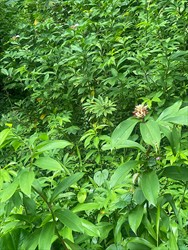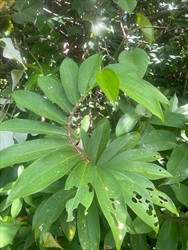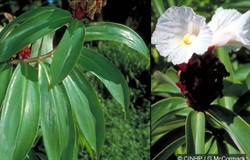Crepe ginger. It is also known as spiral ginger, or variegated ginger.
Pacific Pests, Pathogens, Weeds & Pesticides - Online edition
Pacific Pests, Pathogens, Weeds & Pesticides
Crepe ginger (549)
Hellenia speciosa. Previously, it was Costus speciosus and Cheilocostus speciosus. It is a member of the Zingiberaceae.
Asia, Africa (Mauritius), North (Hawaii) and Central America, Oceania. It is recorded from Australia, American Samoa, Cook Islands, Federated States of Micronesia, Fiji, French Polynesia, Guam, Marshall Islands, New Caledonia, Niue, Palau, Papua New Guinea, Samoa, Tonga, Wallis and Futuna. It is native to tropical and subtropical Southeast Asia, possibly as far as Papua New Guinea.
Extremely aggressive weed, capable of forming dense thickets, and according to CABI has been "listed as an ecosystem transformer" (Photo 1). Growth is rapid in wet, warm climates, where soils are moist clayey loams, pH 5.6-7.5, and shade is provided by mixed deciduous forests. Under ideal conditions a single rhizome will increase to a meter-wide clump by the second year. Where it has been introduced, it can be found growing along roadsides, on waste ground and in disturbed or secondary forests. It is a threat to biodiversity: the formation of thickets displaces native species. From lowland to 1400 masl.
Stems up to 3 m in height, erect or spreading, slightly woody at base, spirally twisting as they age (Photo 2). Leaves, alternating around the stem on short leaf stalks, 5-7 mm, green, shiny above, hairy below, narrowly oval with sharp tips, about 25 by 6 cm (Photo 3 left). Flowers, in a cluster at the top of the stem, up to 15 cm. Each flower with red, leathery, three-lobed, leaf-like structures (fused calyx) surrounding a white corolla of three fused petals, which, in turn, surround the base of a large trumpet-shaped labellum, 5-9 cm long, up to 10 cm wide, crepe-like (hence the name), formed from infertile stamens (Photos 3 right, 4&5). Fruits red and light green containing black, glossy seeds, about 3 mm (Photos 6&7).
Spread is by seeds taken by birds, rodents, or carried in soil on shoes and machinery. It can also spread by vegetative growth of stems and rhizomes. Long distance spread both domestic and international with trade in crepe ginger as an ornamental and for medicinal purposes.
Details of the impact from introduction of crepe ginger into new locations is not well documented, except to note that it is 'invasive', and has the potential to cause loss of diversity. In Cuba, CABI notes that crepe ginger has been classified as a ‘transformer species’, "with the potential to change the character, condition, form and nature of invaded ecosystems". Other examples are provided: in Costa Rica, it is naturalised along roadsides, secondary forests, disturbed sites near cultivation and oil palm plantations. In Puerto Rico, it grows in disturbed moist to wet thickets and roadside banks at low to lower middle elevations. In Pohnpei, it is common in watersheds where the land has been disturbed by growing Piper methysticum, a plant used to make a herbal brew.
Apart from its use as an ornamental, it is also a food and medicinal plant. The rhizomes are eaten as a vegetable and also pickled. It is used in Ayurveda therapies especially in India and Nepal. The rhizomes are used as a purgative, to rid parasitic worms, and to treat coughs. The leaves are used to control diabetes. There has been recent interest in using it as a source of diosgenin for the synthesis of steroid hormones.
BIOSECURITY
The risk of further crepe ginger introductions is high. It is frequently used as an ornamental in tropical gardens around the world and is valued for its medicinal properties. Seeds and plants are readily available for sale on the Internet.
BIOLOGICAL CONTROL
Not a method recommended for Hellenia speciosa.
CULTURAL CONTROL
Physical & Mechanical:
- Hand-pulling isolated plants or small infestations is possible, but make sure all rhizome pieces are collected, otherwise they will regrow. It will need to be done repeatedly.
CHEMICAL CONTROL
In Pohnpei, Federated States of Micronesia, triclopyr is used:
- Foliar spray: on young plants, use diluted product following manufacturers' instructions. Read the label.
- Cut stump/paint: on mature plants, cut stems just above ground and brush or spray product onto them immediately.
____________________
When using a pesticide, always wear protective clothing and follow the instructions on the product label, such as dosage, timing of application, and pre-harvest interval. Recommendations will vary with the crop and system of cultivation. Expert advice on the most appropriate herbicides to use should always be sought from local agricultural authorities.
AUTHOR Konrad Englberger & Grahame Jackson
Information from CABI (2016) Cheilocostus speciosus (crepe ginger). Crop Protection Compendium. (https://www.cabidigitallibrary.org/doi/10.1079/cabicompendium.110397). and Cheilocostus speciosus (J.Koenig) C.D. Specht, Coastaceae. (http://www.hear.org/PIER/species/cheilocostus_speciosus.htm); and from Hellenia speciosa (J.Koenig) S.R Dutta. Royal Botanic Gardens Kew. Plants of the World Online. (https://powo.science.kew.org/taxon/urn:lsid:ipni.org:names:60469691-2). Photo 3 Gerald McCormack, Cook Islands Biodiversity Database, Version 2007.2. Cook Islands Natural Heritage Trust, Rarotonga. (http://cookislands.bishopmuseum.org/). Photo 4 Joy Viola, Northeastern University, Bugwood.org. Photo 5 Sekh Sayantan, Burdwan Eco Garden, Bugwood.org.
Produced with support from the Australian Centre for International Agricultural Research under project HORT/2016/185: Responding to emerging pest and disease threats to horticulture in the Pacific islands, implemented by the University of Queensland and the Secretariat of the Pacific.










